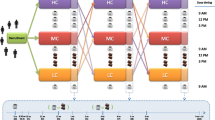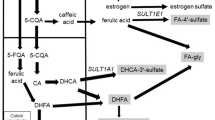Abstract
Habitual consumption of medium amounts of coffee over the whole life-span is hypothesized to reduce the risk to develop diabetes type 2 (DM2) and Alzheimer’s disease (AD). To identify putative bioactive coffee-derived metabolites, first, pooled urine from coffee drinkers and non-coffee drinkers were screened by UPLC-HDMS. After statistical data analysis, trigonelline, dimethylxanthines and monomethylxanthines, and ferulic acid conjugates were identified as the major metabolites found after coffee consumption. For quantitative analysis of these markers in body fluids, targeted methods based on stable-isotope dilution and UPLC-MS/MS were developed and applied to plasma samples from a coffee intervention study (n = 13 volunteers) who consumed a single cup of caffeinated coffee brew after a 10-day washout period. Chlorogenic acid-derived metabolites were found to be separated into two groups showing different pharmacokinetic properties. The first group comprised, e.g., ferulic acid and feruloyl sulfate and showed early appearance in the plasma (∼1 h). The second group contained particularly chlorogenic acid metabolites formed by the intestinal microflora, appearing late and persisting in the plasma (>6 h). Trigonelline appeared early but persisted with calculated half-life times ∼5 h. The plasma levels of caffeine metabolites significantly and progressively increased 2–4 h after coffee consumption and did not reach c max within the time frame of the study. The pharmacokinetic profiles suggest that particularly trigonelline, caffeine, its metabolites, as well as late appearing dihydroferulic acid, feruloylglycine and dihydroferulic acid sulfate formed from chlorogenic acid by the intestinal microflora accumulate in the plasma due to their long half-life times during habitual consumption of several cups of coffee distributed over the day. Since some of these metabolites have been reported to show antioxidant effects in vivo, antioxidant-response-element activating potential, and neuroprotective properties, respectively, some of these key metabolites might account for the inflammation- and DM2/AD risk reducing effects reported for habitual life time consumption of coffee.

Identification of coffee key metabolites in human urine using untargeted MS-based profiling and subsequent targeted analyses in plasma using stable isotope dilution assays




Similar content being viewed by others
References
Eskelinen MH, Ngandu T, Tuomilehto J, Soininen H, Kivipelto M (2009) Midlife coffee and tea drinking and the risk of late-life dementia: a population-based CAIDE study. J Alzheimer Dis 19:85–91
Larsson SC, Wolk A (2007) Coffee consumption and risk of liver cancer: a meta-analysis. Gastroenterol 132:1740–1745
Kempf K, Herder C, Erlund I, Kolb H, Martin S, Carstensen M, Koenig W, Sundvall J, Bidel S, Kuha S, Tuomilehto J (2010) Effects of coffee consumption on subclinical inflammation and other risk factors for type 2 diabetes: a clinical trial. Am J Clin Nutr 91:950–957
Casal S, Oliveira MBPP, Alves MR, Ferreira MA (2000) Discriminate analysis of roasted coffee varieties for trigonelline, nicotinic acid and caffeine content. J Agric Food Chem 48:3420–3424
Weiss C, Rubach M, Lang R, Seebach E, Blumberg S, Frank O, Hofmann T, Somoza V (2010) Measurement of the intracellular pH in human stomach cells: a novel approach to evaluate the gastric acid secretory potential of coffee beverages. J Agric Food Chem 58:1976–1985
Blumberg S, Frank O, Hofmann T (2010) Quantitative studies on the influence of the bean roasting parameters and hot water percolation on the concentrations of bitter compounds in coffee brew. J Agric Food Chem 58:3720–3728
Lang R, Mueller C, Hofmann T (2006) Development of a Stable Isotope Dilution Analysis with LC-MS/MS detection for the quantitative analysis of di- and trihydroxybenzenes in foods and model systems. J Agric Food Chem 54:5755–5762
Lang R, Yagar EF, Eggers R, Hofmann T (2008) Quantitative Investigation of Trigonelline, Nicotinic Acid, and Nicotinamide in Foods, Urine, and Plasma by Means of LC-MS/MS and Stable Isotope Dilution Analysis. J Agric Food Chem 56:11114–11121
Stalmach A, Mullen W, Barron D, Uchida K, Yokota T, Cavin C, Steiling H, Williamson G, Crozier A (2009) Metabolite profiling of hydroxycinnamate derivatives in plasma and urine after the ingestion of coffee by humans: identification of biomarkers of coffee consumption. Drug metabol Dispos 37:1749–1758
Stalmach A, Steiling H, Williamson G, Crozier A (2010) Bioavailability of chlorogenic acids following acute ingestion of coffee by humans with an ileostomy. Arch Biochem Biophys 501:98–105
Wong CC, Meinl W, Glat HR, Barron D, Stalmach A, Steiling H, Crozier A, Williamson G (2010) in vitro and in vivo conjugation of dietary hydroxycinnamic acids by UDP-glucuronosyltransferase and sulfotransferases in humans. J Nutr Biochem 21:1060–1068
Boettler U, Sommerfeld K, Volz N, Pahlke G, Teller N, Somoza V, Lang R, Hofmann T, Marko D (2011) Coffee constituents as modulators of Nrf2 nuclear translocation and ARE (EpRE)-dependent gene expression. J Nutr Biochem 22:426–440
Yazheng L, Kitts DD (2012) Activation of antioxidant response element (ARE)-dependent genes by roasted coffee extracts. Food Funct 9:950–954
Mishkinsky J, Joseph B, Sulman FG (1967) Hypoglycaemic effect of trigonelline. Lancet 290:1311–1312
Yoshinari O, Sato H, Igarashi K (2009) Anti-diabetic effects of pumpkin and its compounds, trigonelline and nicotinic acid, on Goto-Kakizaki rats. Biosci Biotechnol Biochem 73:1033–1041
Van Dijk AE, Olthof MR, Meeuse JC, Seebus E, Heine RJ, van Dam RM (2009) Acute effect of decaffeinated coffee and the major coffee components chlorogenic acids and trigonelline on glucose tolerance. Diabetes Care 32:1023–1025
Viani R, Horman I (1974) Thermal behavior of trigonelline. J Food Sci 39:1216–1217
Stadler RH, Varga N, Hau J, Vera FA, Welt DH (2002) Alkylpyridiniums. 1. Formation in model systems via thermal degradation of trigonelline. J Agric Food Chem 50:1192–1199
Lang R, Wahl A, Stark T, Hofmann T (2012) Identification of urinary and salivary biomarkers for coffee consumption. In: Toth S, Mussinan C (ed) Recent Advances in the Analysis of Food and Flavors. Oxford Print Inc
Lang R, Wahl A, Skurk T, Yagar EF, Schmiech L, Eggers R, Hauner H, Hofmann T (2010) Development of a hydrophilic liquid interaction chromatography – tandem mass spectroscopy based stable isotope dilution analysis and pharmacokinetic studies on bioactives pyridines in human plasma and urine after coffee consumption. Anal Chem 82:1486–1497
Lang R, Wahl A, Stark T, Hofmann T (2011) Urinary N-methylpyridinium and trigonelline as candidate dietary biomarkers of coffee consumption. Mol Nutr Food Res 55:1613–1623
Blanchard J, Sawers SJA (1982) the absolute bioavailability of caffeine in man. Eur J Cin Pharmacol 24:93–98
Butterfield DA, Boyd-Kimball D (2005) The critical role of methionine 35 in Alzheimer’s amyloid β-peptide (1–42)-induced oxidative stress and neurotoxicity. Biochim Biophys Acta 1703:149–156
Arendash GW, Schleif W, Rezai-Zadeh K, Jackson EK, Zacharia LC, Cracchiolo JR, Shippy D, Tan J (2006) Caffeine protects Alzheimer’s mice against cognitive impairment and reduces brain β-amyloid production. Neuroscience 142:941–952
Santos C, Costa J, Santos J, Vaz-Carneiro A, Lunet N (2010) Caffeine intake and dementia: systematic review and meta-analysis. J Alzheimer’s Dis 20:S187–S204
Cao C, Wang L, Lin X, Mamcarz M, Zhang C, Bai G, Nong J, Sussman S, Arendash G (2011) Caffeine synergizes with another coffee component to increase plasma GCSF: Linkage to cognitive benefits in Alzheimer’s Mice. J Alzheimer’s Disease 25:323–335
Chu YF, Chang WH, Black RM, Liu JR, Sompol P, Chen Y, Wei H, Zhao Q, Cheng IH (2012) Crude caffeine reduces memory impairment and amyloid β1-42 levels in an Alzheimer’s mouse model. Food Chem 135:2095–2102
Mori T, Rezai-Zadeh K, Koyama N, Arendash GW, Yamaguchi H, Kakuda N, Horikoshi-Sakuraba Y, Tan J, Town T (2012) Tannic acid is a natural β-secretase inhibitor that prevents cognitive impairment and mitigates Alzheimer-line pathology in trangenic mice. J Biol Chem 287:6912–6927
Rezai-Zadeh K, Shytle D, Sun N, Mori T, Hou H, Jeanniton D, Ehrhart J, Townsend K, Zheng J, Morgan D, Hardy J, Town T, Tan J (2005) Green tea epigallocatechin-3-gallate (EGCG) modulates amyloid precursor protein cleavage and reduces cerebral amyloidosis in Alzheimer transgenic mice. J Neurosci 25:8807–8814
Stazi F, Palmisano G, Turconi M, Clini S, Santagostino M (2004) Accelerated Koenigs-Knorr Glucuronidation of a Deactivated Nitrophenol: Unveiling the Role of Polyamine Additive 1,1,4,7,10,10-Hexamethyltriethylenetetramine1 through Design of Experiments. JOC 69:1097–1103
Fumeaux R, Menozzi-Smarrito C, Stalmach A, Munari C, Kraehenbuehl K, Steiling H, Crozier A, Williamson G, Barron G (2010) First synthesis, characterization, and evidence for the presence of hydroxycinnamic acid sulfate and glucuronide conjugates in human biological fluids as a result of coffee consumption. Org Biomol Chem 8:5199–5211
Korn M, Frank O, Hofmann T, Rychlik M (2011) development of stable isotope dilution assays for ochratoxin A in blood samples. Anal Biochem 419:88–94
Kunert C, Skurk T, Frank O, Lang R, Hauner H, Hofmann T (2013) Development and application of a stable isotope dilution analysis for the quantitation of advanced glycation end products of creatinine in biofluids of type 2 diabetic patients and healthy volunteers. Anal Chem. doi:10.1021/ac303684v
Caubet MS, Comte B, Brazier JL (2004) Determination of urinary 13C-caffeine metabolites by liquid chromatography-mass spectrometry: the use of metabolic ratios to assess CYP1A2 activity. J Pharm Biomed Analysis 34:379–389
Müller C, Lang R, Hofmann T (2006) Quantitative precursor studies on di- and trihydroxybenzene formation during coffee roasting using „in bean“ model experiments and stable isotope dilution analysis. J Agric Food Chem 54:10086–10091
Clifford MN (1999) Chlorogenic acids and other cinnamates – nature, occurrence and dietary burden. J Sci Foods Agric 79:362–372
Verzelloni E, Pellacani C, Tagliazucchi D, Tagliaferri S, Calani L, Costa LG, Brighenti F, Borges G, Crozier A, Conte A, Del Rio D (2011) Antiglycative and neuroprotective activity of colon-derived polyphenol catabolites. Mol Nutr Food Res 55:S35–S43
Somoza V, Lindenmeier M, Wenzel E, Frank O, Erbersdobler HF, Hofmann T (2003) Activity-guided identification of a chemopreventive compound in coffee beverage using in vitro and in vivo techniques. J Agric Food Chem 51:6861–6869
Boettler U, Volz N, Pahlke G, Teller N, Kotyczka C, Somoza V, Stiebitz H, Bytof G, Lantz I, Lang R, Hofmann T, Marko D (2011) Coffees rich in chlorogenic acid or N-methylpyridinium induce chemopreventive phase II-enzymes via the Nrf2/ARE pathway in vitro and in vivo. Mol Nutr Food Res 55:798–802
Hofmann T, Held S, Lang R, Somoza V (2010) Pyrimidinium derivatives for use in the treatment or prevention of diabetes. PCT patent PCT/EP2009/065302, International Publication Number WO2010/055170A1
Chlopicki S, Swies J, Mogielnicki A, Buczko W, Bartus W, Lomnicka M, Adamus J, Gebicki J (2007) 1-Methylnicotinamide (MNA), a primary metabolite of nicotinamide, exerts anti-thrombotic activity mediated by a cyclooxygenase-2/prostacyclin pathway. BJP 152:230–239
Chang MLW, Johnson BC (1961) N-Methyl-4-pyridone-5-carboxamide as a metabolite of nicotinic acid in man and monkey. J Biol Chem 236:2096–2098
Acknowledgments
We thank Mr. Erkan Firat Yagar for roasting the study coffee, Ms. Maren Ilse, Dr. Oliver Frank, and Mr. Benedikt Kohles for skillful acquisition of the NMR data, Ms. Jennifer Gatzemeier for technical assistance, and Ms. Stefanie Meyer for assistance in mass spectrometry. We thank all volunteers participating in the study. We appreciate valuable discussions with Dr. Benedikt Cramer (Westfälische Wilhelm Universität Münster). The pictures used in Fig. 1 were purchased from http://de.123rf.com. The pictures were photographed/generated by Andy Heyward (pile of raw coffee beans), Keisuke Kai (roasted coffee beans), and Mike Kiev (internal human organs woman).
Conflict of interest
The authors have nothing to declare.
Author information
Authors and Affiliations
Corresponding author
Electronic supplementary material
Below is the link to the electronic supplementary material.
ESM 1
(PDF 1312 kb)
Rights and permissions
About this article
Cite this article
Lang, R., Dieminger, N., Beusch, A. et al. Bioappearance and pharmacokinetics of bioactives upon coffee consumption. Anal Bioanal Chem 405, 8487–8503 (2013). https://doi.org/10.1007/s00216-013-7288-0
Received:
Revised:
Accepted:
Published:
Issue Date:
DOI: https://doi.org/10.1007/s00216-013-7288-0




